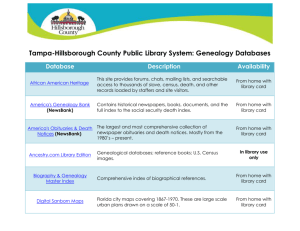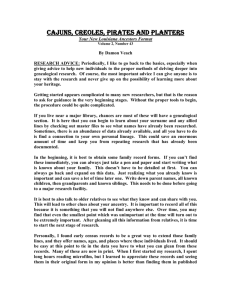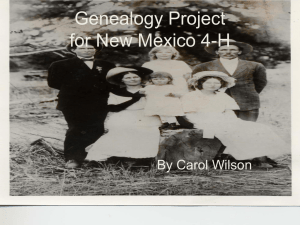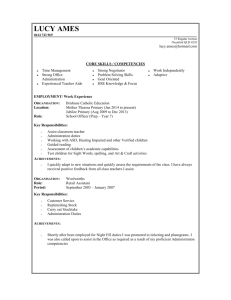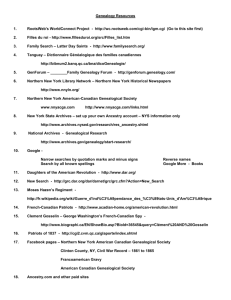Beginning Genealogist - Pittsburg County Genealogical and
advertisement
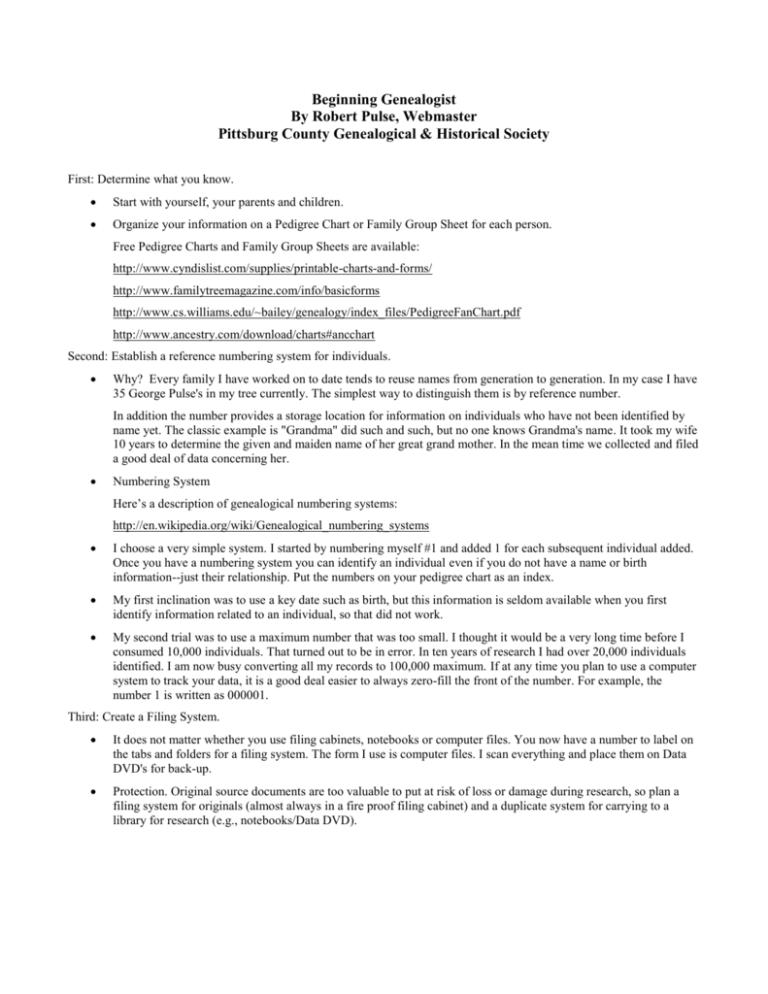
Beginning Genealogist By Robert Pulse, Webmaster Pittsburg County Genealogical & Historical Society First: Determine what you know. Start with yourself, your parents and children. Organize your information on a Pedigree Chart or Family Group Sheet for each person. Free Pedigree Charts and Family Group Sheets are available: http://www.cyndislist.com/supplies/printable-charts-and-forms/ http://www.familytreemagazine.com/info/basicforms http://www.cs.williams.edu/~bailey/genealogy/index_files/PedigreeFanChart.pdf http://www.ancestry.com/download/charts#ancchart Second: Establish a reference numbering system for individuals. Why? Every family I have worked on to date tends to reuse names from generation to generation. In my case I have 35 George Pulse's in my tree currently. The simplest way to distinguish them is by reference number. In addition the number provides a storage location for information on individuals who have not been identified by name yet. The classic example is "Grandma" did such and such, but no one knows Grandma's name. It took my wife 10 years to determine the given and maiden name of her great grand mother. In the mean time we collected and filed a good deal of data concerning her. Numbering System Here’s a description of genealogical numbering systems: http://en.wikipedia.org/wiki/Genealogical_numbering_systems I choose a very simple system. I started by numbering myself #1 and added 1 for each subsequent individual added. Once you have a numbering system you can identify an individual even if you do not have a name or birth information--just their relationship. Put the numbers on your pedigree chart as an index. My first inclination was to use a key date such as birth, but this information is seldom available when you first identify information related to an individual, so that did not work. My second trial was to use a maximum number that was too small. I thought it would be a very long time before I consumed 10,000 individuals. That turned out to be in error. In ten years of research I had over 20,000 individuals identified. I am now busy converting all my records to 100,000 maximum. If at any time you plan to use a computer system to track your data, it is a good deal easier to always zero-fill the front of the number. For example, the number 1 is written as 000001. Third: Create a Filing System. It does not matter whether you use filing cabinets, notebooks or computer files. You now have a number to label on the tabs and folders for a filing system. The form I use is computer files. I scan everything and place them on Data DVD's for back-up. Protection. Original source documents are too valuable to put at risk of loss or damage during research, so plan a filing system for originals (almost always in a fire proof filing cabinet) and a duplicate system for carrying to a library for research (e.g., notebooks/Data DVD). Fourth: Collect family records. Copy as necessary and file forms, papers, documents, photographs, back of photographs, newspaper articles, family heirlooms, bible pages, letters and postcards. If a document contains references to a number of individuals, place a copy in each individual’s file. Start an unknown file. Use this file for people who come up in the research, but you have not identified their places on the family tree at this time. Collect the data for future use. Fifth: Interview Family members to collect data. Guides for oral history interviews are available: http://genealogy.about.com/cs/oralhistory/ht/interview.htm Sixth: Identify what you don't know. Blanks on Family Group Sheets and Pedigree Charts help you identify the missing elements. Dates and places of birth, marriage, and death are the most important elements. Make a list of information that you are missing on your Pedigree Charts, time lines or Family Group Sheets. Prioritize the data holes. Seventh: Develop a research plan for the 5 top information holes in your data. Online help is available: http://www.familytreemagazine.com/article/sample-research-plan http://learn.ancestry.com/LearnMore/Article.aspx?id=2146 Family Histories. Has anyone already written about your family? Check PERSI, in Ancestry and Heritage Quest both are available at the McAlester and Eufaula public libraries. The required barcode is your library card number. Vital Records. Find vital records (birth, marriage, death certificates) for each member of the family to provide names of parents, dates of events, siblings, etc. Some are available on line. Some are available in local genealogical societies, courthouses, and libraries. City Directories and Telephone Books. They may give addresses, names of family members and occupations for a specific date. They are often available in libraries, historical societies, and on line. Census. Do a full census check on your family. This source can give you an abundance of information. The United States took a census every 10 years and the census records currently available to the public are those taken from 1790 to 1930. Several states did census in-between federal years. Indians did their own census and census-like surveys, i.e., Dawes and Miller. Census records are generally available online. Eighth: Plan a trip to a Repository/Archive/Library: Always plan to take a complete set of records (copies—not originals) to a research library. One never knows what will be found in a repository. In fact on almost every occurrence, I have found data on a family line I was not planning to research that day in a vertical file or on a shelf.
